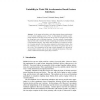Free Online Productivity Tools
i2Speak
i2Symbol
i2OCR
iTex2Img
iWeb2Print
iWeb2Shot
i2Type
iPdf2Split
iPdf2Merge
i2Bopomofo
i2Arabic
i2Style
i2Image
i2PDF
iLatex2Rtf
Sci2ools
MHCI
2004
Springer
2004
Springer
Variability in Wrist-Tilt Accelerometer Based Gesture Interfaces
In this paper we describe a study that examines human performance in a tilt control targeting task on a PDA. A three-degree of freedom accelerometer attached to the base of the PDA allows users to navigate to the targets by tilting their wrist in different directions. Post hoc analysis of performance data has been used to classify the ease of targeting and variability of movement in the different directions. The results show that there is an increase in variability of motions upwards from the centre, compared to downwards motions. Also the variability in the x axis component of the motion was greater than that in the y axis. This information can be used to guide designers as to the ease of various relative motions, and can be used to reshape the dynamics of the interaction to make each direction equally easy to achieve.
Control Targeting Task | Human Computer Interaction | MHCI 2004 | PDA Allows Users | Post Hoc Analysis |
| Added | 02 Jul 2010 |
| Updated | 02 Jul 2010 |
| Type | Conference |
| Year | 2004 |
| Where | MHCI |
| Authors | Andrew Crossan, Roderick Murray-Smith |
Comments (0)

